Come, walk with me.
You have likely seen pictures of the world-famous Mezquita of Cordoba, Spain, have you not?
Are you already familiar with those arches upon arches of striped white and russet red?
Well, today is the day you will see it in the flesh, you lucky duck!

Step one: Identify that the entrance ticket to the the Mezquita is free if you show up before ten in the morning, but also identify that you are a lazy bum who is trying to shake off a flu, and thus a few extra hours of sleep may be worth forking out the 8 Euro ($12 Dollar) afternoon ticket price.
Step Two: Wake up late, eat your meager free hostel breakfast (Corn Flakes… always Corn Flakes), then lope the few blocks to the hulking sand-colored structure and buy your ticket.
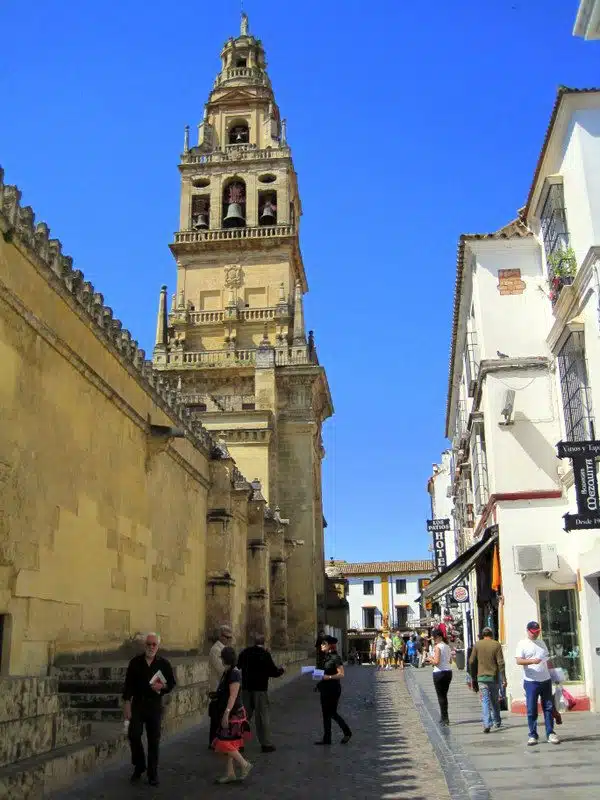
Next, wander around the unassuming courtyard (mmm… those flowering orange trees smell delicious!), and proceed to get embarrassingly lost and confused. Be stunned at your ability to become turned around in a relatively straightforward courtyard.
Finally, swallow your pride and ask a security guard how the heck to actually enter this famous building.
Orientation set, hand your ticket to the guard and stride into the cool darkness.
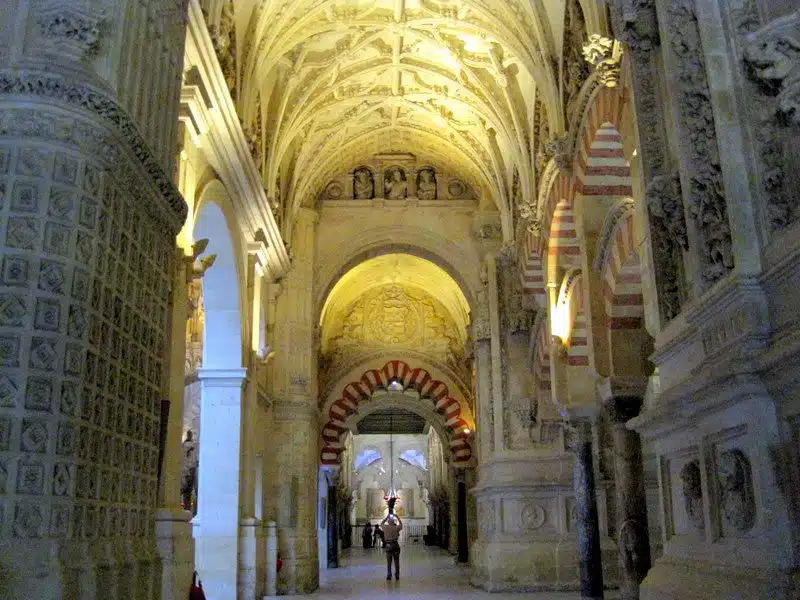
Step Three: Hear your heart holler: “HOLY HEAVEN!!!”
All the pictures you saw before most certainly did NOT convey the power that is smacking you in the face with celestial oomph!
You saw those arches reprinted on paper, but did you realize that they stretch on, and on, and on, and– oooh!— they continue around the next three corners! Walk around with an awe-struck shuffle, mouth agape, heart a-thump.
On all sides of you, other tourists are murmuring: “Splendid! Just splendid!” and, “Ooh, it is LOVELY, honey!” Or my favorite: a throaty, euphoric moan of ecstasy.
But like a Cadbury Creme Egg, sampling the outer layer of the Mezquita is just the beginning. Did you know that the Mezquita is actually a church turned mosque turned church? And the architecture is all the more fascinating for it.
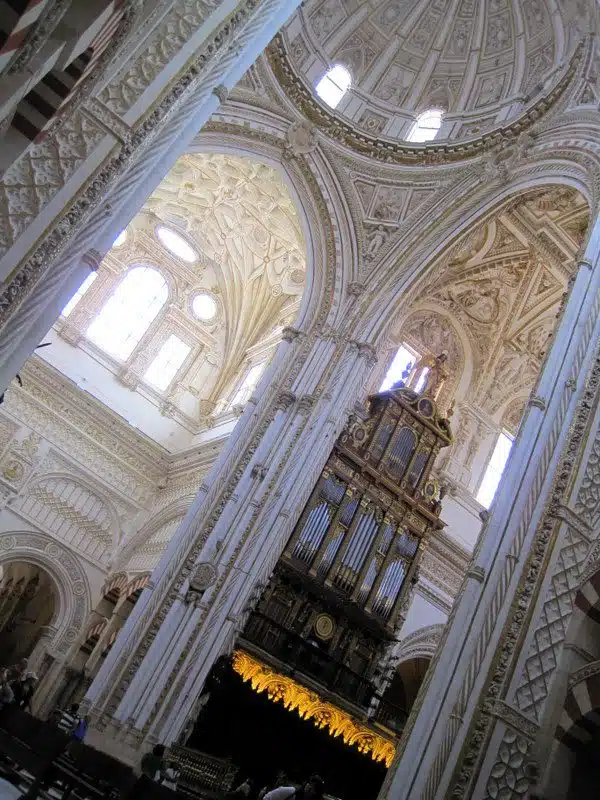
History of La Mezquita in Cordoba, Spain:
In the year 400 A.D. the Visigoths began building the structure as a Christian church. In 784 A.D. it was bought by an Emir and made into a massive mosque which was added to and added to with each coming year.
For the subsequent centuries, that Great Mosque of Cordoba (not to be confused with the Grand Mosque of Abu Dhabi) was the heart and soul of the Islamic community of Al Andalus.
Even today it remains the largest Mosque in Western Europe– although it is not technically a Mosque anymore. (Turkey’s Hagia Sophia has a similar switching back and forth from mosque identity.)
After the Spanish Reconquista, the Great Mosque was seized by King Ferdinand in 1236 and turned into a Catholic house of worship.
A huge and holy church, along with endless glittering Jesus sculptures, was inserted right into the MIDDLE of the delicious Moorish architecture. Talk about pushing one religion on (or in this case, into) another!
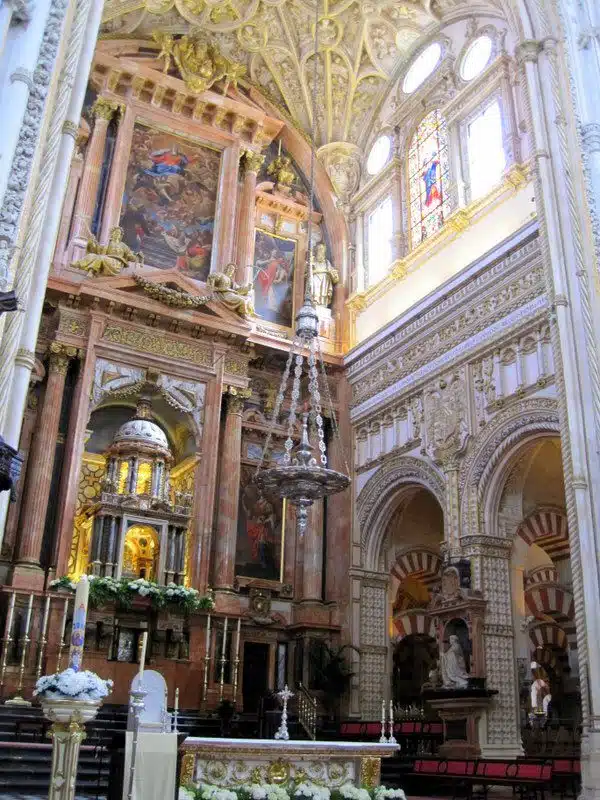
And this brings us to the scrumptious center of this magical building. Walk past the thousands upon thousands of wonderful Islamic arches, and suddenly– OH!– there is a zillion-foot-tall ceiling in the center with creamy white curls of decoration so tender and delicate, you will want to lick the pretty walls (like the inside the Taj Mahal! But please do not. This is a house of worship, after all.
I spent a ton of time gasping and cooing at the loveliness (bopping between the Islamic and the Christian sections), all the while crouching in different frog-like positions to try to show you, oh reader, the scale of it all with my little point-and-click camera.
I hope you can somewhat get a feel for the power of the Mezquita’s enormity through these shots! Look for the teensy tiny little humans in each photo to get an idea of how wee you feel when inside.
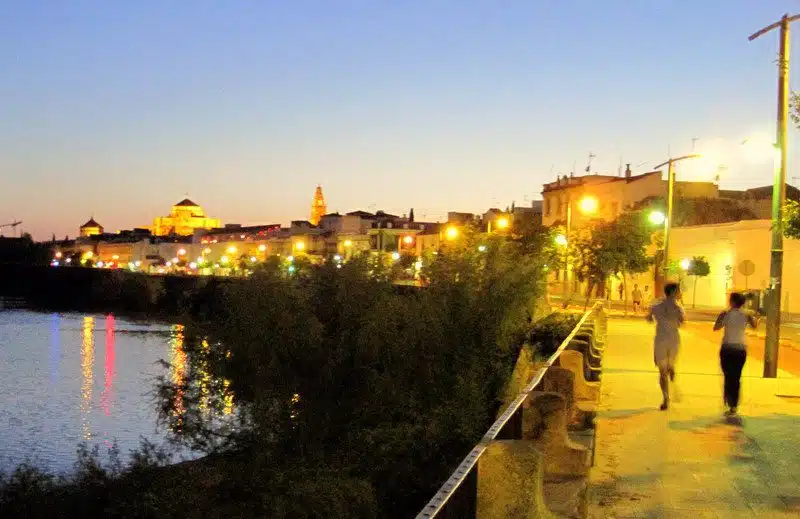
So how does this building reflect the town it is in? Well, Cordoba, Spain, was (for a time) a historically fabulous example of harmony in diversity.
In old Cordoba, Christians, Muslims, and Jews lived, worked, and traded side by side, each group contributing its talents and structures to the city.
If you walk through the charming streets of Cordoba today, you will see a breathtaking church here, and an ornate Islamic door decoration there; a great Synagogue here, and the biggest Mosque in Western Europe there.
Unfortunately, I recently heard a rumor that, because many Muslims still hold the Mezquita as a holy place and try to pray, special Catholic “Prayer Guards” now prowl the premises to hurl any non-Catholic worshiper out the door.
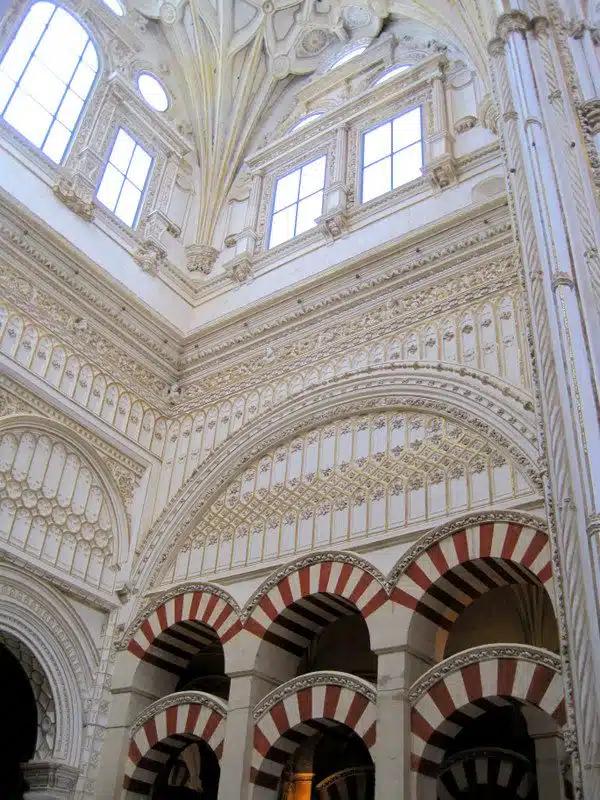
If this is indeed true, it seems rather too bad. Why not (asks the naive mixed child) have areas for each group to pray within the same building?
There are theories afoot that children of mixed parentage are the most beautiful: from Black-White Barack Obama to my Japanese-Welsh college roommate Meg, to, well, Jewish-Christian me!
But whether or not it is actually true that crossbreeding creates hotter humans, you really get the feeling standing in the Mezquita that it is true for art!
When you mix the best of Islamic architecture with the best of Christian architecture– hoo man!– you get a wonder of the world.

The author, Lillie Marshall, is a 6-foot-tall National Board Certified Teacher of English, fitness fan, and mother of two who has been a public school educator since 2003. She launched Around the World “L” Travel and Life Blog in 2009, and over 4.2 million readers have now visited this site. Lillie also runs TeachingTraveling.com and DrawingsOf.com. Subscribe to her monthly newsletter, and follow @WorldLillie on social media!

Mario I. Arguello
Thursday 13th of January 2022
I stopped here looking for ancient architecture structures. In particular buildings built with gold, copper, metal caps, that resemble domes, and have tall antenna-like metallic objects at the top. There is no doubt that there is an amazing force in the creation of the buildings themselves, from an artistic point, if we will. But I am re-searching, not their art, but the mechanics of them.
But with an intricate eye for detail and knowledge in other subjects, that eye sees a world built within a source of bountiful energy and in today's so call modern technology, electricity may not be that new of a discovery but an modification of a cleaner and more abundant and free source that perhaps was harnessed in the majestic architecture of antiquity, conveniently lost by the realization of modern commerce, for profit of those at the very top of the economic system, the rulers of the world, so to speak.
The process of harnessing that antique energy, through air is not very much different than transmitting it as we do today with modern communications systems. People take for granted that communication via airways, in less modern times may have been interpreted as a form of magic. What! you can talk and see another person via a handheld device? If we take this analogy and interpolated or reverse it, then it is not farfetched to understand its inverse, in modern times.
Religion and the Occult are two parallels while at the same time being inverses, but that is a complete topic in itself and while both are apparent in the sequence of change and perhaps the real purpose why some of these buildings of antiquity went from one stage to another, we can leave that for another time.
Getting back to the electrical aspect of the buildings, the arcs and columns architecture of La Mesquita, the dual tone arcs resemble transformer cores without modern day copper windings, of the alternating type to be more specific, easily seen in modern day electromagnetic brushless motors, while the columns, share similar physical qualities as metal electrodes by nature of how electrodes wear out in an electrical circuit or device. The darker portion at the base is what would be expected from the constant heat or current and thus become charred or carbonized. It is amazing how these show similarities, just by looking at the photos of the columns. If I was there personally I am sure I would not be looking at how the architectural details resembled that of a wedding cake, and I probably stay there longer to try to break down some interesting questions.
The average mind, cannot not grasp this easily, and may seem unfathomable, but if we are of the opinion we have lived here on earth before, I think this group of people have a much better understanding of things, on a natural basis, meaning without much enlightenment or diving into forbidden knowledge, than to the average person.
While still on the subject of energy, electricity in particular, and how this is a huge modern money making platform, through the use of copper distribution in the form of power lines, consider the word CATHedral. The word cathode seems to pop right out of it, and perhaps with good reason. If these particular structures were built with the purpose of harnessing power, such as for batteries, of the galvanic type, in particular, then we have a cathode and anode, elements in a process of electrolysis, where electrolytic or galvanic cells play a role. Galvanic cells have existed in ancient times, and these are simply composed of a ceramic container, copper, iron and an acid as simple as lemon juice to make an electrochemical cell.
Gold domes with Copper metal rods on top of them. The world has been romanced so much the with visual icing of the cake and not enough about the ingredients and the true nature of things seem to be right in before our very own eyes with some deeper thought and understanding. MIA
Lillie Marshall
Thursday 13th of January 2022
This is fascinating, Mario! Thank you for taking the time to share these important insights.
Penny Sadler
Sunday 30th of June 2013
I love churches and you're right this one is a treasure. I was in Granada where the Cathedral was built over a mosque but luckily the Alhambra still stands. The stark contrast of the two was very interesting. I think it's a great idea to allow multi-denomination worship and yes, probably naive too. :)
Majida
Monday 15th of April 2013
sexy architecture - eh ;) Just had to laugh at your Tag? Category ? Keep it up!! On another note, i think, I will subscribe to you as a student to wordpress, your blog is well organized and easy to read...
Lillie
Tuesday 16th of April 2013
Thanks!
Majida
Wednesday 13th of February 2013
Beautifully written, just as if I 'd walk in the marvelous layer of religions and traditions again, was there last year and can very much relate to your essay! The idea of giving everyone a place to pray within is a great idea!
Lillie
Wednesday 13th of February 2013
So glad that you were able to visit, too, and that you can relate!
The World of Deej
Friday 18th of November 2011
Just awesome...we really enjoyed Spain, and hope to return one day soon. It is funny you mentioned lousy hotel breakfasts...thats what I wrote about yesterday:)